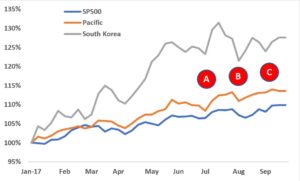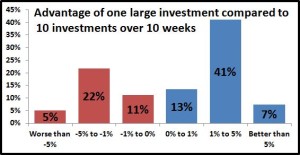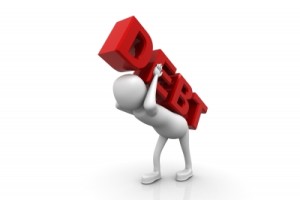We all know that stocks have been on an absolute tear lately (that’s the reason I’m smarter than a Nobel Prize winner). In fact, if you look at 11 months since Donald Trump was elected, stocks are up about 20%.
On election night the S&P 500 was at 2140 and now it’s at 2550. It’s blown through major milestones like 2200, 2300, 2400, and a few weeks ago 2500; all in fairly short order. If you are fully invested you’re loving it and obsessively looking at your spreadsheet to see how your net worth is climbing (okay, maybe that’s just me).
If you aren’t invested, this is a definite missed opportunity. There are a couple ways you can go with that:
- Just don’t invest because you feel you missed the boat already.
- Go all in now to not miss any more.
- Hold off to wait for the market to fall again, and then invest on the dip.
As you can probably guess, I think #1 is a bad idea and I would recommend #2. However, what about #3?
Waiting for the downturn
We all know that stocks have been on an unrelenting upward path. The S&P 500 started at 17 in 1950. Today it is over 2500. Of course, it’s never a smooth path. You’ve had bumper years like this one, really since 2008, all of the 1980s and 1990s, etc.
You’ve also had your downturns. Some have been long grinds like the 1970s while others have been sharp like the Great Recession. However, even with those, we’ve definitely done well. That said, if you missed out on a good run, should you just wait for the next downturn to get back in?
First, I believe that it’s impossible to time that well. But let’s say your crystal ball is working really well. How often will stocks fall back so you can get back in at the lower levels you missed before?
I looked back at the S&P 500 since it started in 1950, and I looked at all the major milestones for the index. On January 1, 1950 it started at 16.66, so the first major milestone was 20. It passed that level in Oct 1950 and it never looked back. Never again did you as an investor have a chance to get in at 20*.
Same story for milestones 30, 40, and 50. In the 1950s the stock market did its relentless march, and every time it passed those levels they were never seen again.
It was a different story in the late 1960s and early 1970s. A MAJOR milestone was hit in June 1968—100 on the S&P 500. You could imagine this was accompanied by the usual fanfare of surpassing such a level. The 1970s proved a lousy time for stocks, and the S&P 500 had major moves above and below 100 eleven times. That’s a lot. It wasn’t until the Reagan bull market of the 1980s that the stock market broke the trend.
For milestones 150, 200, 400, and 500 there were no pull backs (300 had a pullback thanks to the crazy one-day plunge in 1987). So again, just like the 1950s, the 1980s and 1990s had a stock market that just blazed through, and if you missed it you missed the boat. Never again would those levels be seen again.
| Milestone | First time | Revisited |
| 20 | Oct-50 | 0 |
| 30 | Jul-54 | 0 |
| 40 | Jun-55 | 0 |
| 50 | Sep-58 | 0 |
| 75 | Dec-63 | 2 |
| 100 | Jun-68 | 11 |
| 150 | Mar-83 | 0 |
| 200 | Nov-85 | 0 |
| 300 | Mar-87 | 2 |
| 400 | Dec-91 | 0 |
| 500 | Mar-95 | 0 |
| 750 | Nov-96 | 0 |
| 1000 | Feb-98 | 3 |
| 1500 | Mar-00 | 6 |
| 2000 | Aug-14 | 3 |
| 2500 | Sep-17 | 0 |
Since the 2000s we’ve crossed four major milestones—1000, 1500, 2000, and most recently 2500. All of those were revisited, mostly due to the Great Recession where the S&P fell from about 1565 all the way down to 670.
Since the Great Recession, the market has been blazing, but it’s been crazy in the process. The market cleared 2000 in August 2014, but has gone through some brief downturns with fast recoveries like January 2016. I think more recently we’ve experienced greater volatility in the market, so revisiting might be more common.
Bottom line
That was a gripping history lesson, but what does that mean we should be doing now? Overall, I think the data shows that stocks always go up. Sure there will be bumps, but if you invest now, the data shows that, at least based on history, you’ll make money.
On the other hand, despite this crazy good bear market recent years, there have been revisits of these levels. Are we going to see the S&P 500 at 2000 again? Maybe. Based on recent history, I wouldn’t be surprised. However, I certainly wouldn’t bet on it. I mean that in the literal sense—I wouldn’t wait to invest my money until I saw a market downturn. I think it more likely things will keep cranking along and 10 years from now we’ll remember the good ole days when the S&P was at 2500 the same way we think about $0.10 hamburgers from McDonald’s.
You might have missed this boat, but you don’t want to be on the sidelines when the next boat (S&P 500 at 3000) comes around and miss that one too.
* I defined “revisited” is going under the milestone at least 100 days after it passed it. This is to keep from counting times when it gyrates above and below the milestone over the short term. For this we wanted to look at times where the market was comfortably above the milestone and then at a later time period fell below it.











